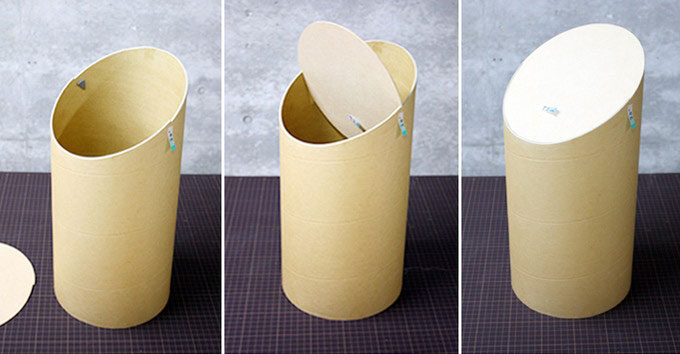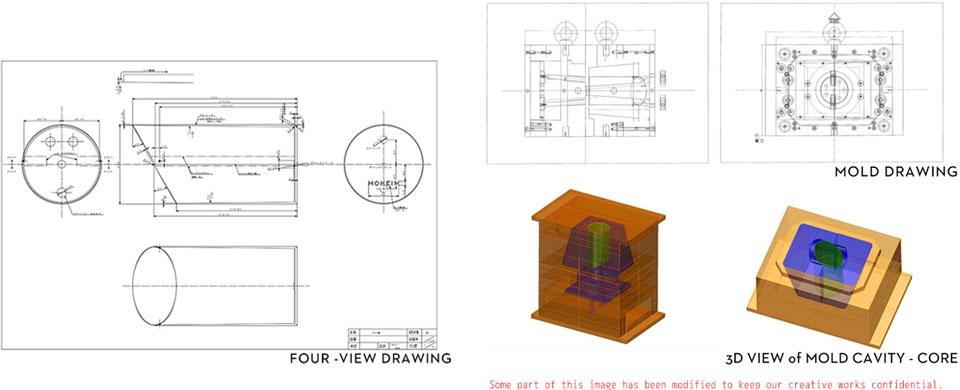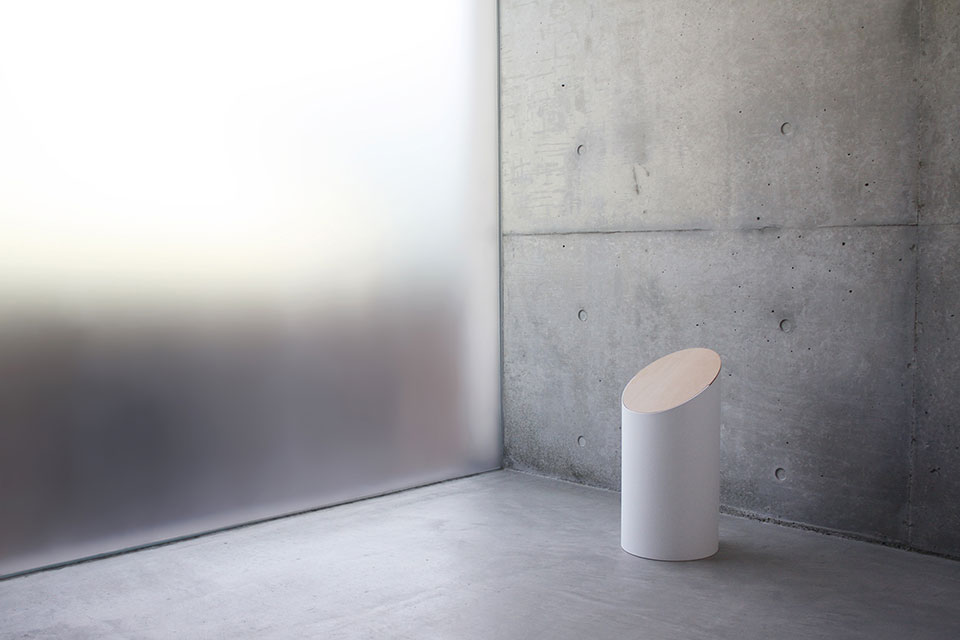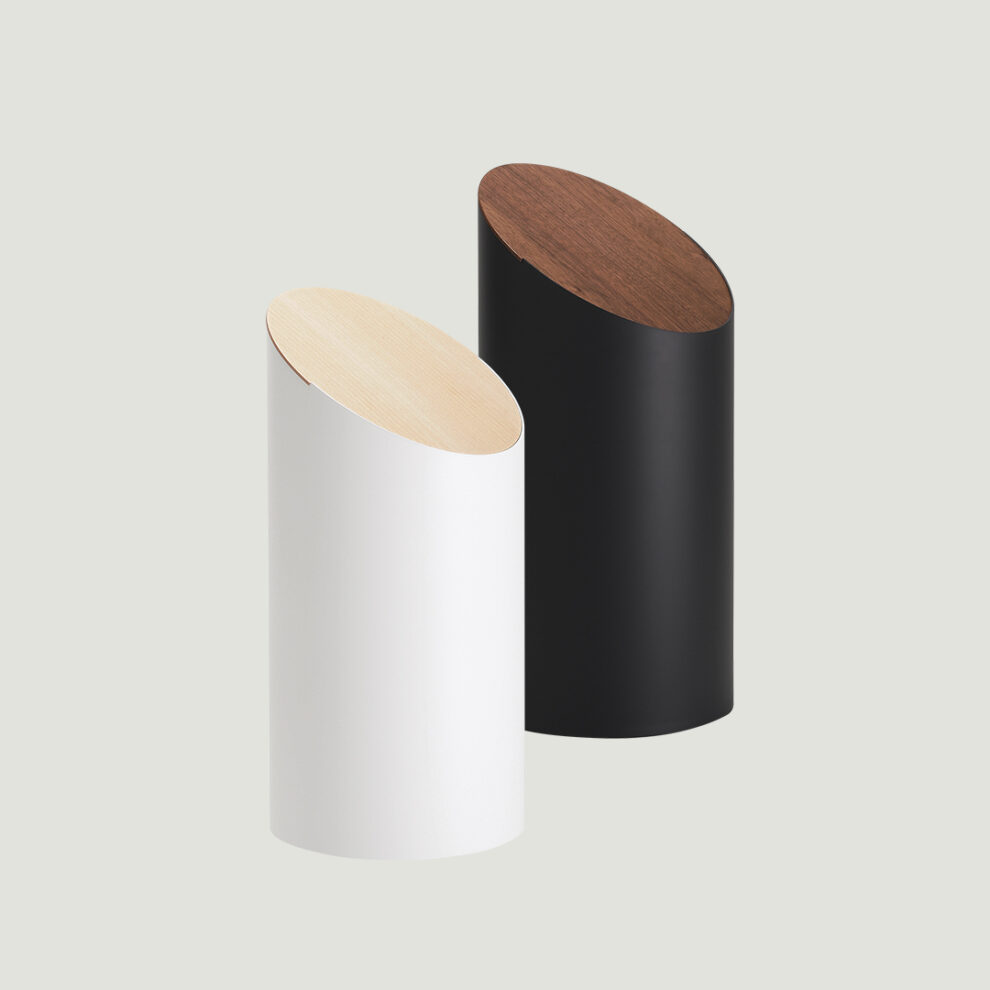SWING BIN
Actually, we can say that the MOHEIM brand began with this item.

In form it stands like a sculpture which embodies the ultimate minimalism.
SWING BIN, as a sophisticated object,
makes a space more ideal and beautiful.
PRODUCT STORY Vol.1

— We think that SWING BIN is a really iconic and symbolic item among MOHEIM items. What is the concept behind the design?
The first motive to create SWING BIN was my desire, “I want to create a beautiful dustbin which people have never seen before and which fascinates design-conscious people all over the world.”
I thought its details out in order to complete the product with a special sense of the primitive form which everybody has seen in the everyday life no matter when or where. I felt that this was “the start of a new phase of SWING BIN” when its mass-production was finally fixed and arranged.
 Cardboard model
Cardboard model
— Please tell us the specifics of the lid which “SWING”s, as it is the source of the name of the product.
The lid is a quite simple structure, and it is just placed on the top of the bin. However, it can be opened or closed very smoothly, and taken off from the body.
The requirements for this opening and closing mechanism are the cylindrical body cut obliquely on top, a slight level difference on the top on which to hang the lid, and a cut on the edge of the lid. That’s all.
There are stoppers for preventing the lid from falling down from excessive rotation, but there are no screws, gears, or wires. This point can be said to be both the “function” and “design” of this bin.
— When I first saw the movement of the lid, I thought it was interesting and wondered why it could be opened and closed so smoothly.
Yes, when you tap the lid, it opens slowly while keeping its balance. And the lid returns to the closed position shortly thereafter. This motion itself is so very elegant that you will be looking forward to throwing something into the bin.
Also, the lid can be taken off without any special operations, you just grab it to remove it or put it on the top to cover the bin. It is so easy to remove or put on that it means that it is easy for you to throw all the trash inside away. This is also an advantage of this bin.

— When did the SWING BIN gather attention?
The prototype was completed in 2009, and was exhibited for Milan Design Week (Milano Salone) in 2010. It attracted so many people and got the DESIGN AWARD 2011 by “wallpaper*” which has been called “the most influential life style magazine.” At the same time, SWING BIN was selected as one of the “Design Directory 2010/11 Top 25 products” by “MONOCLE,” the magazine established by Tyler Brûlé, who was the chief editor of “wallpaper*” at the time of its foundation.
I was so glad and honored because this meant that SWING BIN’s beauty of design and its function were highly valued. Moreover, it received a GOOD DESIGN AWARD in 2016 after its release to the market and a lot of different media published articles about SWING BIN.
— So, it sounds like SWING BIN had a great start in the first place.
It was highly evaluated in Milan and featured in many media outlets, so I had a lot of inquiries and offers.
However, hurdles for mass-production were actually so high, and 2-3 years had passed without any production. I gradually got to know that substantial cost would be required even for just the mold production.
— What was the solution you chose for it?
We decided to try “Crowdfunding.”
Actually, Crowdfunding wasn’t very well known at that time, and even its name wasn’t common in Japan. However, I believed that “there are a lot of fans waiting for the release of SWING BIN in the world, so I would be able to generate funds for it.” In 2014, I opened the project on “Kickstarter” which is the biggest crowdfunding sight in the world.
— How much was the targeted amount of the project?
It was $65,000 USD. By the way, most projects on Kickstarter at that time were mainly focused on electronic gadgets or anime.
So, a project for an interior product was pretty unusual and rare. However, so many people supported this project, and it was able to achieve its goal. Moreover, SWING BIN gathered funds of $77,377 USD from 571 supporters mainly from Europe and the U.S. This amount was the 2nd highest record of support in the “interior” category of Kickstarter at that time.
— Then, you were able to secure enough funds for the production of SWING BIN?
It was a great thing for me to gather the funds from a lot of supporters who highly admired SWING BIN’s extreme minimalist design, which was its most characteristic point. However, we found out that the entire development would cost about $100,000 USD…
“The beautiful bin which nobody ever seen” required not only a beautiful design, but also detailed and delicate calculations, repeatedly making and failing with the prototypes, and more than anything else, high-skilled techniques to realize the ideal design.
— But you never gave up, did you?
We had so many prototypes, failures, and corrections, that it sometimes seemed to be difficult to proceed any further with the project. However, Plastics Co., Ltd* and I solved all the problems together.
SWING BIN’s body is molded with a “split mold” in order to keep its perfect cylindrical shape (absolutely vertical line against the floor). The parting lines on both sides are made as inconspicuous as possible so that the texture on the surface feels smooth and beautiful.
Moreover, the surface of the inside of the body has a pretty complicated curved surface in order to make the thickness of the cut end of the top (opening) even.

— Did you have any twists and turns before deciding on the material of the body?
I think that steel is the common material for making dustbins.
But eventually bins made of thin steel get dents or scratches and they become noticeable. Also, I couldn’t stand the part where the metal is joined on the surface… “This is absolutely NOT beautiful.”
So, we went on a quest for the best material considering both the ideal design and the practical aspects of SWING BIN, and found the answer was an ABS resin which has a high-class feel and intensity among plastics.
The tranquil matte texture is created by 2 processes applied to the material – make slight bumpy texture of a surface, and put a clear urethane matte paint over the surface.
 Left:Steel Prototype, Right:Aluminium prototype
Left:Steel Prototype, Right:Aluminium prototype
— Were any functions added on during the development phase?
A project supporter via Kickstarter suggested us “it is not practical to have dustbins where a garbage bag cannot be attached to the inside.” To address this, we improved the specifications during the project.
The solution of this was very simple. We just put a rolled PVC sheet along the inside surface of the bin. Obviously, it didn’t change the appearance, but it satisfied the users’ demand. It is a kind of optional part, so it doesn’t have to be attached to the inside if users don’t need a plastic bag.

— By the way, why did you come up with the idea to design a dustbin in the first place?
A trash can is an item people often use in everyday life, so it tends to be put in a place where it catches people’s eye. Also, people would not like to let other people see the trash inside of their trash cans, especially if those people were invited to their house or office.
For that reason, many people choose a trash can with a lid. Including me. But most of the designs of bins with lids which are sold in the marketplace I have seen are “THE” trash can. So, I simply wanted to have a beautiful bin with a lid. This was the origin of my efforts to design a dustbin.
Actually, I would like people to see SWING BIN as a simple and minimal “object,” not only as a trashcan. That means, a beautiful object which fits into the interior but also has the function of a dustbin, I guess.
Thus, I would like people to know and use SWING BIN, especially the people who tends to “hide” their bins.
Moreover, I hope SWING BIN can change your space or interior to more ideal and beautiful one.

Item information
